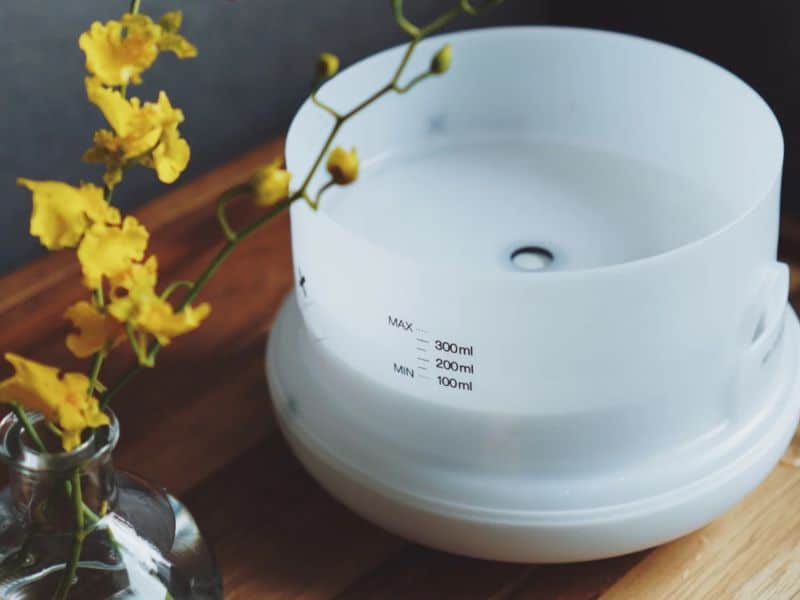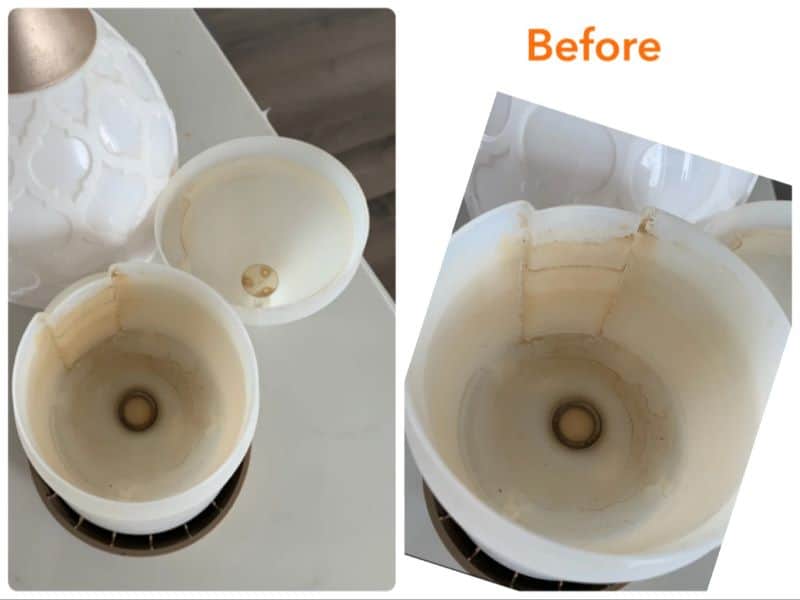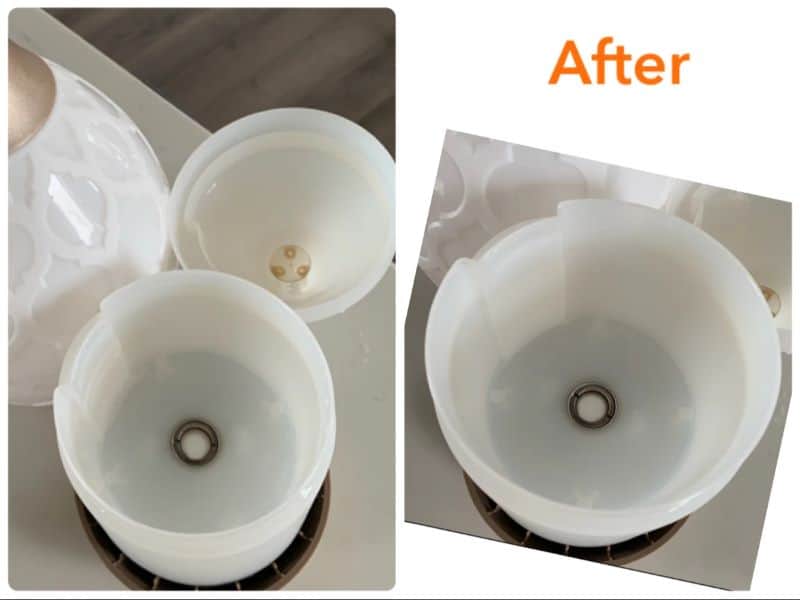Essential oil diffusers are a health and wellness tool used daily in many homes. Diffusing oils can reduce anxiety symptoms, boost your mood, improve respiratory health, and more. But can diffusers also release mold spores into the air?
When a diffuser is cleaned regularly, it is unlikely to develop mold. But neglecting to care for your diffuser can lead to mold growth. If you’ve gone days or weeks without cleaning your diffuser, that needs to change.
In this post, I’ll share why you want to keep your diffuser clean, how to go about doing it, and possible alternatives to water-based diffusers.

Inhaling Mold Is Not Okay
It seems counterintuitive to diffuse essential oils to improve your health, but neglect to prevent mold growth, which can cause illness. But that’s what so many people do, often unintentionally.
Mold and mildew are actually pretty common. We come in contact with them in some way daily. It’s not until they begin to accumulate in one area that they potentially become a problem.
Mold loves to grow in damp, dark places. Whether it’s clothing, plants, wood, drywall, carpeting, or almost any other moist surface, mold will spread so long as there’s oxygen and the temperature isn’t too cold.
Once these spores begin to grow, they can cause irritations and/or allergic reactions when touched or inhaled.
If inhaled, it can cause eye irritation, runny nose, sneezing, and possibly red eyes. It can even trigger an asthma attack in those with asthma who are allergic to mold.
This is why it’s important to prevent mold from growing in your oil diffuser.
What’s the Difference Between Mold and Mildew?
Mildew is a form of mold and they’re both a type of fungi. Mildew is what you’ll probably notice in the early stages of mold growth. It only takes a day or two for mildew or mold spores to begin to reproduce.
Although one leads to the other, there are some differences in their appearance and the extent to which they cause harm.
Mildew appears flat and looks powdery white or gray. Although it thrives in moisture, mildew will look dry. It can have a mild musty smell and is often found on surfaces.
Mold is often raised and fuzzy or slimy. It’s got a wider color range including green, black, red, and blue. Mold’s odor is more stenchy, you can’t mistake it for anything else. It can sink into surfaces, making it harder to locate.
In terms of health, mold, especially black mold, can cause more severe illness than mildew.
How to Clean an Essential Oil Diffuser
So you can see why maintaining your diffuser is so important.
Many people avoid sanitizing their diffusers regularly, but luckily, most diffusers are easy to clean. Keeping it clean is not only good for your health, but it prolongs the use of your diffuser.

Here are some simple steps to follow.
- First, you want to open and empty out your diffuser. If you notice mold beginning to grow, pour rubbing alcohol onto a disposable cloth and wipe the interior of your reservoir. Clean any areas where you see the mold.
- Next, rinse and fill the reservoir with fresh water. Add one teaspoon of vinegar. I dislike the smell of white vinegar, so in addition to the vinegar, I would add one or two drops of lemon essential oil. But it’s up to you.
- Diffuse this solution for at least an hour.
- Once the cycle is complete, your diffuser should be fresh and clean. Wipe it down and allow it to air dry.
If necessary, repeat the steps once more.

This water-vinegar solution also prevents bacterial buildup and discourages dust mites from making their home in your diffuser.
How Often Should You Clean Your Essential Oil Diffuser?
You can find the best answer to this question in the user manual that arrived with your diffuser.
Generally, it’s good practice to diffuse the water/vinegar solution every three days if you use your diffuser daily. The longest I might go without cleaning it would be one week, but that’s a stretch.
If you only use your diffuser occasionally, then it’s best practice to clean it after every third use in order to prevent mildew growth.
How Else Can You Prevent Mold Growth In Your Diffuser?
In addition to maintaining a cleaning regimen, there are a few things you can do to prevent mold from growing in your diffuser.
Don’t allow water to sit in your diffuser for days on end. If you know that you won’t be using the machine for a while, empty it. Allow it to air dry, or use a towel to absorb any water before closing the lid again.
Diffuse antifungal essential oils from time to time. This is a preventative measure that can help keep your machine in a good condition in between cleanings.
Some antifungal essential oils include:
- Citronella
- Clove
- Eucalyptus
- Geranium
- Oregano
- Peppermint
- Tea Tree
At least once a month, do more extensive cleaning. This applies to those who frequently use their diffuser. Depending on how your diffuser is designed, there might be tight corners or crevices that need cleaning. If this is the case, I’d suggest pouring a water-vinegar solution into a bowl, and then using a q-tip or similar object to dig into those tighter areas.
Gently and safely clean any area that you can access. Afterwards, you may want to diffuse water and vinegar, and then water alone to rinse all the inner workings of the diffuser.
Remember to let it thoroughly dry afterwards.
Clean before long storage. If you plan to store your diffuser for an extended period of time, you’ll want to follow the steps above to clean it with the water-vinegar solution. Make sure it’s completely dry before storing it.
Alternatives to Ultrasonic Diffusers
Want to avoid mold growth in your diffuser altogether? The only way to do that is to buy a diffuser that operates without water. Two options come to mind: nebulizing diffusers and a waterless diffuser plug-in.
Nebulizing Diffusers
These diffusers use an air pump to break essential oils down into tiny particles. Particles are suctioned up, forming a fine mist that’s then dispersed into the air.
Since water isn’t used, the essential oils don’t become diluted. Therefore, the mist that’s released is highly concentrated and smells stronger than what’s released from an ultrasonic diffuser.
Another positive point is that instead of plastic, their reservoir is often made of glass and has a wooden base.
There are three downfalls to nebulizing diffusers: they’re typically louder, use more essential oil, and are more expensive than ultrasonic diffusers.
A fourth point, which may or may not be a deal breaker for you, is that nebulizing diffusers won’t act as a humidifier since they’re waterless. If you need a humidifier, then this wouldn’t be the best option for you.
But if you want to prevent the development of mold in your diffuser, nebulizing diffusers are one of the few good alternatives that operate in a similar fashion.
As an aside, if you are sensitive to certain essential oils, you may not want to use this type of diffuser due to its more concentrated output.
Here are a few that I like:
XANAPHIA Nebulizing Diffuser with Touch Sensor Lighting
- This one actually runs quietly. It’s also got a colored base unlike many of the other models.
Shukra Atomizer Nebulizing Essential Oil Diffuser
- A rarer reservoir type, this one most closely resembles an ultrasonic diffuser, but it doesn’t require heat or water to function.
- Handcrafted, this reservoir is made of hand blown glass. Its wooden base is carved by hand. It does not have an LED light.
Aroma-Ace Essential Oil Atomizing Diffuser
- This version comes with a noise reducer apparatus, but you will still hear it operating. Instead of dropping oils into the diffuser, you screw the atomizer onto an essential oil bottle.
Uone Essential Oil Diffuser for Aroma Nebulizing
- Similar to ArOmis, but more compact, this one is also handcrafted but has an LED light option.
Waterless Diffuser Plug-in
I recently learned of this nifty invention. For decades scented wall plug-ins made with only a small amount of essential oils have dominated the market. But it looks like things are changing.
GuruNanda Portable Plug-In Oil Diffuser
- Instead of filling your home with the aroma of synthetic fragrance oils, you can diffuse undiluted essential oils.
As far as I know, these are the only alternative diffusers that will release pure essential oils within your home without the use of water.
In Conclusion
Mildew and mold can begin to grow in diffusers that aren’t well maintained.
For your health and optimal machine use, it’s imperative for you to regularly clean your ultrasonic diffusers and allow for ample drying time. This is especially true if used infrequently or packed away for a long period of time.
If you have deep concerns about mold growth, I would suggest that you invest in a nebulizing diffuser.
